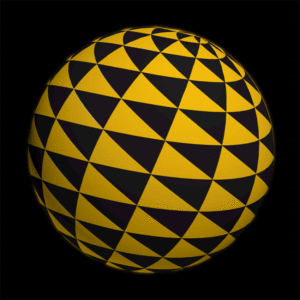Pre-Letter E
I am really happy to receive the letters with your remarks, because thanks to your opinions I make every possible effort to describe the sounds in more detail. This is very important to me because I often use metaphorical and figurative manner of speaking since I consider certain concepts as evident.
It is this very sense of obviousness that hinders the expression of certain thoughts and concepts because you certainly cannot know my state of mind. One of the sounds that turned out to be the most difficult to describe is the Pre-Letter "C" associated with "K" and "Q".
It took me a few weeks to think about how they could be better presented and I think that after completing their descriptions, it is worth returning to them now.
When describing the Pre-Letter "D", I have already mentioned the specific inspiration that accompanied me while writing, because this letter does not refer to the cosmic and animal worlds, but only to man as a product of his mind and hand. There are still a few Pre-Letters whose sounds were created in a similar way.
The "E" sound is very interesting and appears just as a symbol that in fact refers to all worlds and dimensions. In the case of "D" the material reference point was the letter "D" in the Egyptian language, and in the case of "E" there is nothing really obvious that could be indicated.
Fortunately, we live in the 21st century and you can refer to the modern imagination of man, which is based on visualisation related to science.
Let's start with the graphic presentation of this sound in the form of a horizontal wave:

Originally it could have been drawn depicting the concept horizontally, but for some reasons it had to be turned to a vertical position. One of the reasons was the collision in terms of shape with the Pre-Letter "N".
It may be surprising, because although the modern "W" resembles this wave, in those times "W" had fewer bends than today.
So in order to better reflect this idea and avoid graphic collision, the wave was turned vertically.

So how one could characterise this wavy line? It is difficult to give precise answer to this question. Definitively, it is easier to indicate its meaning.
The pre-letter "E" in the form of a wave symbolises creation.
It's about primary creation that can reproduce itself in a cycle of recurring births and deaths. The association is simple, because one only needs to think about the situations in which we pronounce "E".
The point is to undertake a closer examination of the way we pronounce the sound itself. It appears spontaneously between spoken thoughts. It constitutes the background for the words being born. We pronounce the sound "E" while the brain is involved in answering the question or continuing thinking. It is an extensive space that you could write a lot about. Simply put - in adolescence, our brain empirically classifies data that we provide it in the form of waves.
Some of them are in the form of sound, others are in the form of light, and others in the form of warmth.
There are many other types of waves that our body receives, but we deny to assign them significance - I call this denial "judgment." I will write about "judgment" and its role in due time. Returning to the issue of information provided in the form of waves, it should be emphasised that they are received using the optic nerve or hearing apparatus, as well as receptors such as skin and muscles. These data are then analysed by the correct hemisphere of the brain and by the corresponding fragment of the cerebral cortex. Such classified information no longer requires verification when we are adults. When we see - we know what we see, and when we feel - we know what we feel. Looking at the background image and analysing it, learning about objects and their purpose, as well as people and their behaviour, and filtering it somehow through our experience - we assess the meanings, we select only the context that is important to us and then we decide how we want to react to it.
All these operations take the form of pulses. Each has approximately 78 billion neurones that connect to each other through synapses. Thanks to synapses, the nerve impulse is transmitted chemically or electrically.
The electric one is transmitted faster because the depolarisation wave does not have to be converted into a chemical agent after reaching the synapse. In such a synapse, an electric impulse jumps through synaptic vesicles from the membrane of one neurone cell to another.
I am emphasising this fact in order to remind you that everything we experience can be considered both waves and energy. Both this energy and the waves were created somewhere by something or someone. Of course, one can be skeptical with regard to the interpretation that the man of Great Culture had knowledge of the waves.
However, I would recommend to refrain from one-dimensional assessments, given the nature of dolmens and other energetic places scattered around the world. Nevertheless, we can illustrate this wave by referring to something more acceptable from our point of view today - as the state of mind of a man of Great Culture, i.e. a phenomenon in nature that can be observed with the naked eye. This phenomenon is a wave or rippling water when we call the shape it takes as a result of the influence of the factor that gives it this form.
If that factor is wind, then its cause is as invisible as it is.
Let us remember that a similar observation can be made when we see a vibrating image of the surroundings in hot air.
Indeed, the attraction properties were considered extremely important in that time. The testimony of the awareness of the phenomenon of electrostatics survived in the minds of the Greeks - because this culture was spared from destruction, about which I will write further. I think that during the time of Great Culture, electrostatics was widely known. It's about the properties of amber called the electron. This fossilised resin rubbed with fur has attractive properties.
One can, however, ask why were amber nuggets so valuable in the world of Great Culture?
I think that it was because of this very property, and the traces of its description can be found in many myths and legends - I will return to this topic in further essays.
Admittedly, it is very interesting issue because amber has become a "divine" stone for man. These observations of a man of Great Culture could have contributed to the creation of the symbol of creation - i.e. the wave. Today we use words related to the phenomenon of wave: energy, electricity, echo.
Let us remember that the wave is, in fact, a visual-mathematical idea.
Furthermore, the concept of energy could be ridiculed and found its reference in a word such as witchcraft, which in Portuguese is: enfeiticar.
Therefore, the Pre-Letter "E" symbolises the experience of something that transcends tangibility. Also, what we see and hear, and yet do not touch, has a mark of tangibility.
Greek myths emphasise this intangibility. The Greeks had in their mythology the nymph Echo, who lost her voice. She was punished so that she could not say anything out of her will, but only repeated someone else's words.
Echo was also to be torn to shreds as punishment, and then brought back to life by Gaea, who showed her mercy because of her beautiful voice repeating sounds. Echo's father was the Ether "god" of bright light. Aristotle, in his philosophy of nature, called the Ether the fifth element constituting the "supra-moon" world. "God" Aether, for the Greeks, was born of Nyks ("goddess of the night") and her brother Ereb ("god" of darkness). Nyks and Ereb were children of Chronos and Ananke. Chronos and Ananke as "primal gods" had no parents. Chronos was described as the personification of time and builder of all things, and his sister Ananke was identified with the necessity.
Thus, when we look at this genealogy, we can draw the analogy with the big bang theory. For me, this theory is a repetition of Greek myths, just as Echo repeated someone else's words, and also a repetition of beliefs of the Great Culture, which should also be understood as knowledge.
Recently, it has been claimed that the Big Bang arose from dark matter in which our world collapses from time to time.
One may ask whether we are experiencing the "discovery" of ancient knowledge? Cyclicality was once the axis of the narrative, and also of the self which constituted man. This narrative has been interrupted and we are now returning to it through science. No wonder, for most of us, America was discovered by Columbus, and we call it in this way, because it was Amerigo Vespucci who competed with him for the right to be considered the first discoverer of this continent. The German cartographer Martin Waldsemüller settled this dispute. And his proposition to give it the name "New World" has been accepted.
This is an example of constructing the self in which we find ourselves, because you probably do not want to believe that it was Columbus and Amerigo who first came to America? Similarly is with regard to the image of the letter "E", which has ceased to look and mean what it originally symbolised. Since this kind of practice seems to be effective, me, as their discoverer, suggest that you call Pre-Letters Teodor Kosch Pre-Letters, including the letter "E" as the symbol of creation.
When describing the Pre-Letter "E" as a symbol of creation, it is impossible not to refer to another Greek "god", Eros. He is a very popular character today. Admittedly, man always wants something he does not have. This condition is often described by saying that "the heart was pierced by the arrow of Eros".
Something we do not have and what we always crave for is love, and the latter - when we manage to complete it - gives birth to a new being.
One may ask: can we keep this love? It is ephemeral and, like us, a new being born of it, will strive to connect with another being, seeking what it cannot achieve alone. As you can see, for millennia, Eros symbolises something – as to say - which is always between extremes, since Plato pointed to its position between the realm of mortality and immortality. Due to his love for wisdom, Plato defined Eros as a philosophy, that is, the love and desire of his beloved Sophia. Interesting is the shape of the letter S, which is at the beginning of the word wisdom (greek: “Sophia”) and which looks almost like E.
I think that it is not the case here, so you should listen carefully to Plato and, following him, attribute Eros a place between lack of " aeternum "and possession of" aeternum ".
Latin reveals that the Romans "slaughtered" the Etruscans too quickly and did not realise that aeternum was tantamount to non-eternal, or mortal, to them. This is not the only word whose meaning has been distorted. However, other Celts knew this and they were already using the word correctly.
Despite the Romanisation in French, we have its right wording: éternité. I will not further problematise this issue now and will not focus on Etruscans by posing the question about what they - in my opinion - put in front of this word. This theme will be elaborated further in the upcoming essays.
I would like to only add here that existence, and therefore creation, is connected with being – that is the one, who can be considered the creator. Therefore one should also assume the existence of the sign that precedes it. Its absence here has its ideological reason, which I will try to describe in more detail in further essays.
I believe that its consequence, until recently, was that the world was born out of nothing, that's the Big Bang theory. Yet, has something really sprung unaided for no reason? Was anyone there and saw it? Whatever happens has its cause - this is my experience, and in this case someone came up with the theory according to which something once "boomed" out of nothing. But how should non-being exist?
And that is why we have to take into account the revision of this theory, i.e. it is as a transition from being to being. Physical - scientific - reincarnation. This explains why, from time to time, we find ourselves in a "black hole" and the whole story, which has been told many times before, is happening again.
However, there is nothing to worry about, because before this is going to happen, probably, many civilisations will revive, including ours, the statement which can also be found in many holy books.
Although they sound unbelievable, I suggest you consider my statement as true as in the Big Bang theory - I am referring to your imagination here as scientists do.
I am very happy with this revision, because earlier somehow I was just sad to read that the sun will burn out.
It is not about worrying about the very end of the world, since I feel that it is distant prospect and in the perspective of my life it will not happen, but still the vision that it will finally happen was depressing form my point of view.
Admittedly, if it was me who was posed by Plato the question of who Eros is, I would probably say that for me he constitutes something between knowledge and faith, because they are perceived as opposing each other. It is there that scientists find their hypotheses, and yet they love so much to search for it. Perhaps Plato could also call this etheric-ephemeral space philosophy? I don't know that, perhaps it is likely because the esoteric hermeticism was developed by followers of Plato's philosophy.
Etymologically, most of the words related to energy associated with the Pre-Letter "E" come from the Greek language, but "E" existed and meant the same as in the Greek also in other languages, as will be shown in the following essays. This sound, preceded by another sign, will reveal its very meaning.
The crucial issue yet remains valid: Why the Pre-Letter "E" considered as a wave is not associated with the letter of the Latin alphabet?
I think the explanation must refer to the fact that it was originally painted on stones and then engraved in rocks or wood. When the paper became the popular medium for writing letters, the shape of "E" changed significantly in relation to the way it was used by the Etruscans and Greeks. It is exactly this changed shape that makes it difficult for us to identify "E" with the wave.
Read other essays about the great achievements of Great Culture!

